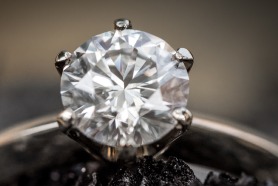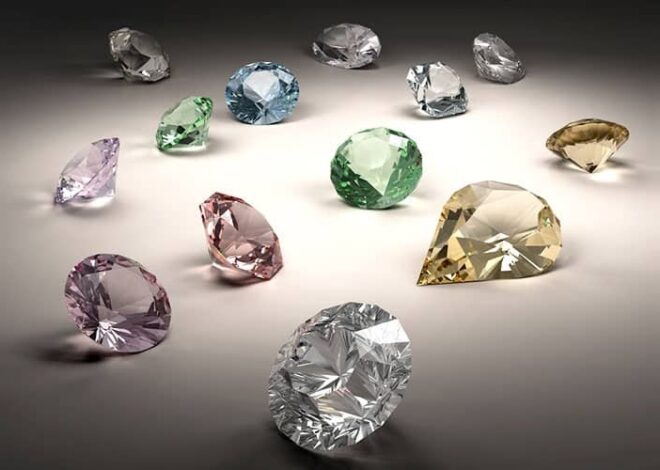
Unveiling the Brilliance of Diamond 4c
Diamonds, those scintillating marvels of nature, have captivated humanity for centuries. More than just beautiful gemstones, they are symbols of love, commitment, and enduring value. But what truly defines a diamond’s quality and worth? The answer lies in the diamond 4c: Carat, Cut, Clarity, and Color. Developed by the Gemological Institute of America (GIA), this universal grading system provides a standardized way to assess diamond quality, empowering buyers to make informed decisions. Understanding the 4Cs is not just about technical jargon; it’s about appreciating the intricate factors that contribute to a diamond’s unique beauty and sparkle.
Carat: The Weight of Distinction
Often mistaken for size, Carat actually refers to a diamond’s weight. One metric carat is equivalent to 200 milligrams, or one-fifth of a gram, and is subdivided into 100 “points” for precise measurement. So, a 0.50 carat diamond can be referred to as a “50-point” diamond.
While carat weight generally correlates with a larger physical appearance, it’s crucial to remember that two diamonds of the same carat weight can look different in size depending on their shape and, most importantly, their cut. A poorly cut diamond may retain more weight in its pavilion (bottom) than in its crown (top), making it appear smaller than a well-cut diamond of the same carat.
Larger diamonds are rarer and, consequently, more valuable. However, the increase in price isn’t linear; a 1-carat diamond will cost significantly more than twice the price of a 0.50-carat diamond of similar quality across the other Cs. When considering carat, it’s essential to balance weight with the other quality factors to ensure you’re investing in a diamond that truly sparkles.
Cut: The Masterpiece of Light
Of all the 4Cs, Cut is arguably the most crucial for a diamond’s beauty, as it directly impacts how a diamond interacts with light, dictating its brilliance, fire, and scintillation. It’s not about the diamond’s shape (like round, princess, or emerald) but rather the artistry and precision with which a diamond’s facets are proportioned, symmetrical, and polished.
A masterfully cut diamond will reflect and refract light optimally. When light enters a well-cut diamond, it travels to the pavilion, reflects off the internal surfaces, and returns through the table (top facet) to the viewer’s eye. This phenomenon creates:
- Brilliance: The total white light reflected from a diamond.
- Fire: The dispersion of white light into its spectral colors (rainbow flashes).
- Scintillation: The flashes of light and dark areas (sparkle) as the diamond moves.
The GIA grades diamond cut from Excellent to Poor for round brilliant diamonds, which have established ideal parameters. Fancy shapes (non-round diamonds) are evaluated more subjectively. A diamond with a “Poor” cut grade will appear dull and lifeless, regardless of its color or clarity, because light leaks out from the sides or bottom rather than returning to the eye. Investing in an excellent cut diamond ensures maximum sparkle and visual appeal.
Clarity: The Fingerprint of Nature
Clarity refers to the absence of inclusions (internal characteristics) and blemishes (external characteristics) within a diamond. Formed deep within the Earth under immense heat and pressure, nearly all diamonds contain some “birthmarks.” While some are microscopic, others can be visible to the naked eye and affect a diamond’s transparency and brilliance.
The GIA Clarity Scale has 11 grades, assessed under 10x magnification by a skilled grader:
- Flawless (FL): No inclusions or blemishes visible under 10x magnification. Extremely rare.
- Internally Flawless (IF): No inclusions visible under 10x magnification, but may have minor blemishes. Also very rare.
- Very, Very Slightly Included (VVS1 and VVS2): Inclusions are so minute that they are difficult for a skilled grader to see under 10x magnification.
- Very Slightly Included (VS1 and VS2): Inclusions are observed with effort under 10x magnification but can be characterized as minor. Generally “eye-clean” (no inclusions visible to the naked eye).
- Slightly Included (SI1 and SI2): Inclusions are noticeable under 10x magnification and may or may not be eye-clean, depending on their size, location, and nature.
- Included (I1, I2, and I3): Inclusions are obvious under 10x magnification and may affect the diamond’s transparency, brilliance, or durability. These are usually visible to the naked eye.
The position, size, number, nature, and relief (contrast) of these characteristics all contribute to the clarity grade. For most consumers, a VS2 or SI1 diamond offers excellent value, as these grades are often eye-clean at a more accessible price point than FL or IF diamonds.
Color: The Spectrum of Whiteness
When referring to white diamonds, Color actually describes the absence of color. The GIA color-grading scale ranges from D (colorless) to Z (light yellow or brown), with subtle variations in hue making a significant difference in value. Truly colorless diamonds (D, E, F) are the rarest and most valuable.
The color grades are:
- Colorless (D, E, F): These diamonds show virtually no color. D is the highest grade, representing absolute colorlessness. E and F are still considered colorless, with only minute traces of color detectable by a trained gemologist.
- Near Colorless (G, H, I, J): These diamonds appear colorless to most untrained eyes, especially when mounted. As you move down the scale, slight hints of yellow become increasingly apparent when viewed face-down or compared side-by-side with higher grades. G and H are popular choices for their balance of quality and value.
- Faint Yellow (K, L, M): A noticeable yellowish tint is present.
- Very Light Yellow (N, O, P, Q, R): A more pronounced yellow hue is visible.
- Light Yellow (S, T, U, V, W, X, Y, Z): A distinct yellow or brown color is evident.
The choice of color often depends on personal preference and the metal of the setting. A slightly warmer diamond (e.g., G-J) can look beautiful in yellow gold, as the metal can complement the diamond’s tint. For platinum or white gold settings, consumers often prefer diamonds in the D-F or G-H range to maintain a crisp, colorless appearance.
The Interplay of the 4Cs: Finding Your Perfect Diamond
The diamond 4c are not independent entities; they are interconnected and collectively determine a diamond’s overall beauty and value. A diamond with exceptional clarity and color might appear dull if its cut is poor. Conversely, a diamond with a less perfect color or clarity grade can still dazzle with an excellent cut.
There’s no single “best” combination of the 4Cs; the ideal diamond is a balance that aligns with your priorities and budget. For example, if maximizing sparkle is your goal, prioritize an Excellent cut. If you desire a larger stone, you might consider compromising slightly on color or clarity. Many experts recommend prioritizing cut first, then color (aiming for G-J for a near-colorless appearance), then clarity (seeking VS2-SI1 for eye-cleanliness), and finally, carat weight based on your budget.
Tips for Buying a Diamond
- Prioritize Cut: Always aim for the best cut grade your budget allows, as it has the most significant impact on a diamond’s brilliance.
- Consider “Eye-Clean” Clarity: Instead of paying a premium for Flawless or Internally Flawless, consider VS2 or SI1 diamonds that appear clean to the naked eye.
- Choose Color Strategically: For white gold or platinum settings, D-H colors are generally preferred. For yellow gold, you might consider I-J colors, as the metal can mask subtle yellow tints.
- Balance is Key: Work with a reputable jeweler to find the optimal balance of the 4Cs that fits your aesthetic preferences and budget.
- Always Request a Certificate: Insist on a diamond grading report from an independent and respected gemological laboratory like the GIA or IGI. This certificate provides an objective assessment of the diamond’s 4Cs and ensures transparency in your purchase.
Conclusion
The 4Cs – Carat, Cut, Clarity, and Color – are the fundamental pillars of diamond quality. By understanding these characteristics, you gain the knowledge and confidence to navigate the world of diamonds and select a stone that not only symbolizes your unique story but also truly embodies exceptional beauty and everlasting brilliance. With informed choices, your diamond will be a radiant testament to your discerning taste and a cherished treasure for generations to come.


